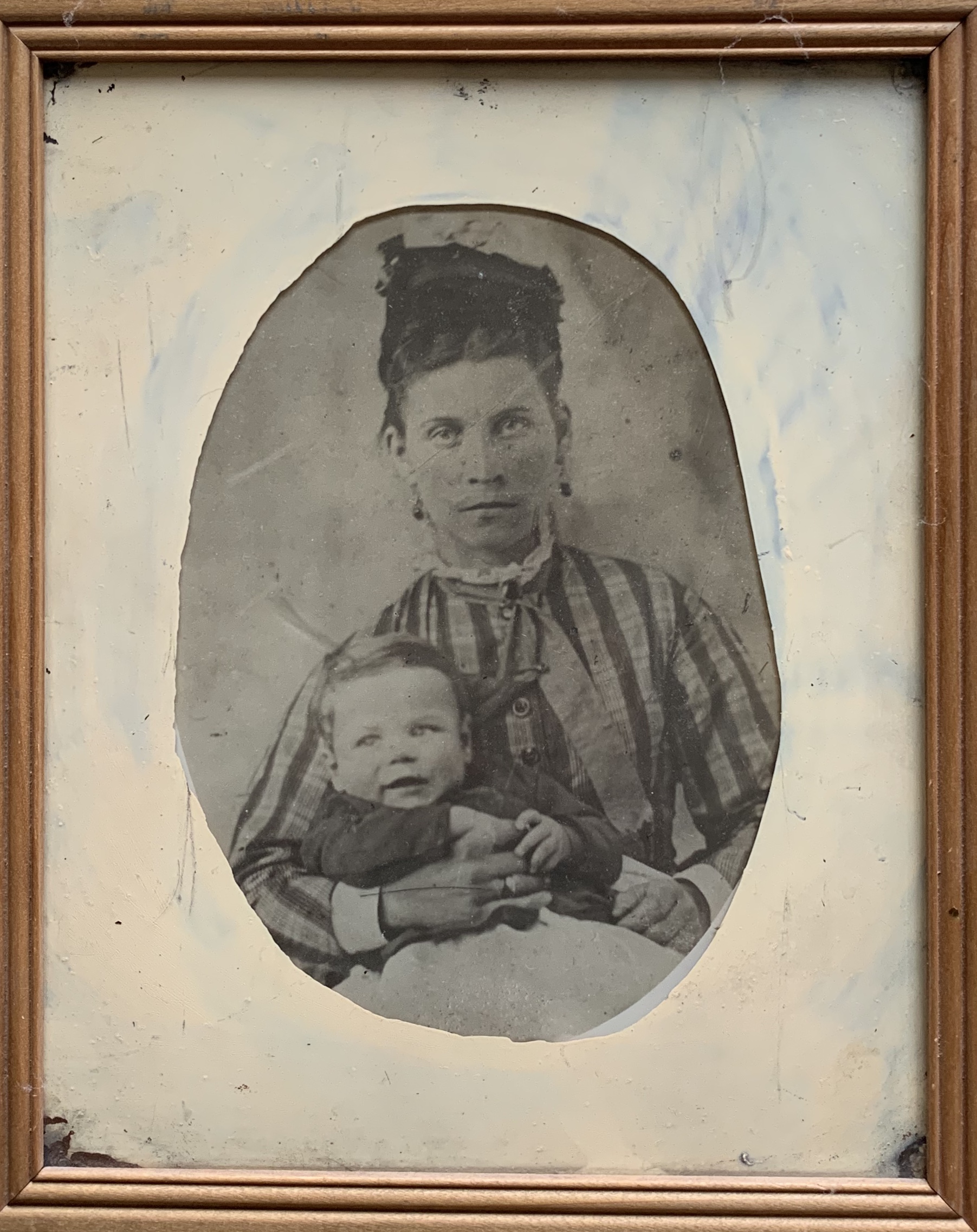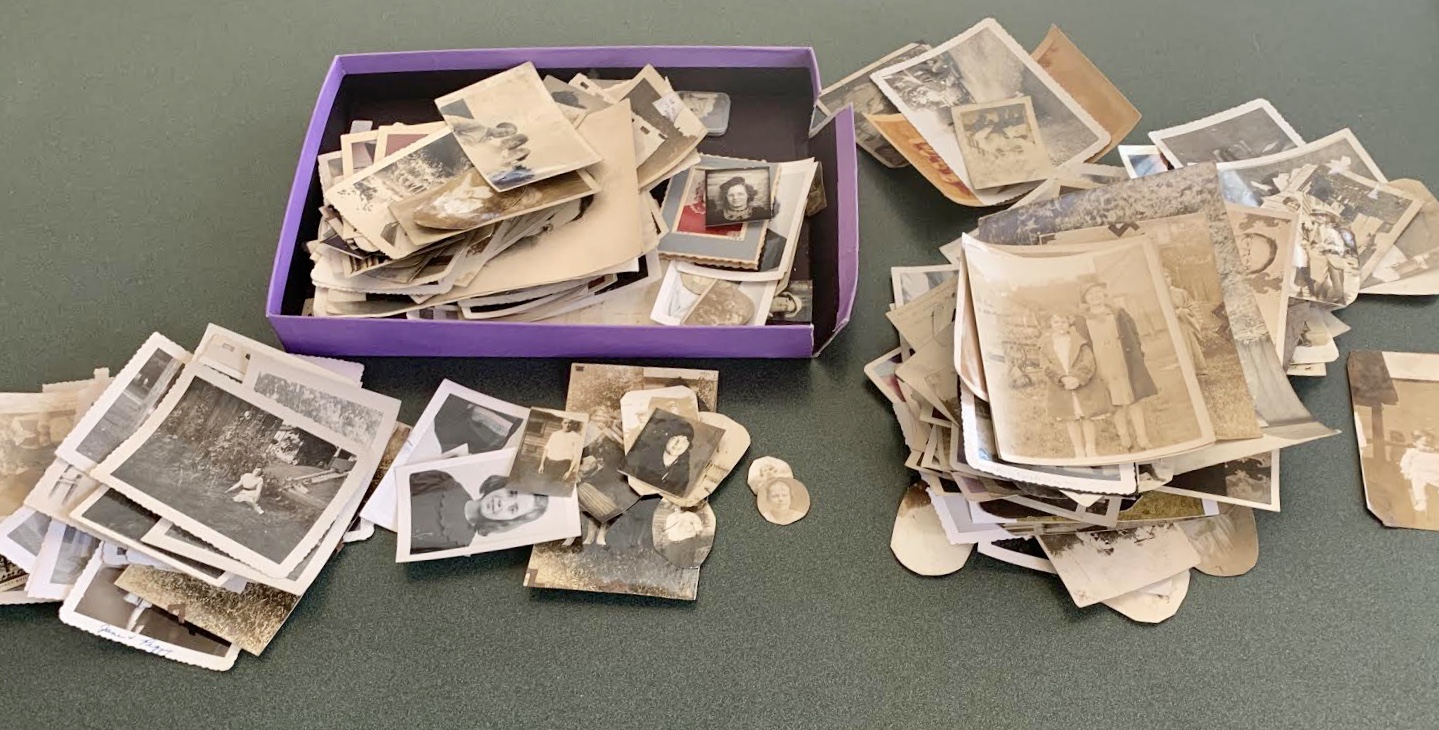I had these two great aunts – we’ll call them Edith and Gladys Melton (because those were their names) – who lived to be 94 and 92, respectively. They were at least half Irish, their mother was a Riley who had not one but two lines going back to Miles Riley who came to Virginia from County Cavan in 1634. They lived their entire lives in the small town in western Pennsylvania where they were born, in the one-time schoolhouse that had been their childhood home, where they grew up with their eight siblings. They were of a different era, one in which people designated them “old maids” or “spinsters.” They took care of their mother until she died at the ripe old age of 94, they were career girls who worked for over 40 years at the G.C. Murphy five and dime store in town, their front door was always open and their kitchen was always welcoming.
But this isn’t a story about my great aunts. It’s a story about their photos.
Make no mistake about it, they loved pictures. When they were younger, they loved being the subject of them, and as they grew older they made sure no one left their house without smiling for the camera. They collected, and hoarded, photos. It’s difficult to imagine in the instaworld of today that there was once a time when images were not so easily shared, and who got to keep the only portrait of Granddaddy could ignite a family feud to rival that of the Hatfields and McCoys. But, oh, there was indeed such a time. And it was no secret that these two sisters were sitting on a vast collection of family photos that had been hidden away from the world for almost a century.
Edith and Gladys passed away within a year and a half of one another, a little over 10 years ago. Two of their nieces were named executors of their estate, and the fate of these photos was in their hands. I had been given brief glimpses into the enchanted vault over the years and my worst fear was that the photos would be thrown away. Because as all genealogists know, there are two kinds of people in the world: those that love old photos, and those that toss them. But my aunt and my cousin knew how much the pictures meant to me and how much work I had already done on the family tree, and they presented me with boxes and albums of photos. I even got custody of the portrait taken in 1876 of my second great grandmother holding my great grandfather as a baby (that’s the photo you see up at the top here). This one, and I kid you not, was hidden in the basement, tucked in the rafters, wrapped in tissue paper and interred in a shirt box.
But great blessings come with their own burden. I was now in possession of thousands of photos that spanned a period of over 100 years, were mostly unidentified, and included a mix of family, friends and acquaintances of two women who were no longer around to provide me with any information. The initial excitement was more than enough to get me started. I began by removing all the photos that had been glued to the black construction paper albums popular from the early 1900s to the 1950s. Those albums are toxic to pictures. They are acidic and eat away at the images. It’s a difficult and time consuming task, and I felt bad about dismantling the albums, but it’s a necessary first step. I was especially thrilled by the old photos that had been identified, and separated them so I could share them with cousins.
And then reality set in. Now what do I do? It was overwhelming, and over the next ten years I would take the boxes out, start going through the photos, become frustrated and return them to the boxes until the next bolt of inspiration hit me. The little bit of progress I made never seemed to offset the daunting reality of the project in front of me.
It’s now 2020, and a number of circumstances have reignited my fire to identify and organize this treasure trove of images that deserves to be preserved and shared with everyone to whom they might mean something. I’ve been working on the photos for at least a little bit every day for the past month, and have developed my own organizational system that I hone as I go along. I purchased four boxes, and assigned three of them to specific branches of the family, and the fourth to photos involving people and places of the town. Within each box, I have envelopes. For instance, one box is designated for my great grandparents, their children and descendants. Because there aren’t that many photos of my great grandparents, any photos I find of them share an envelope labeled with their names. Each of their 10 children, including my grandmother, has their own envelope for their photos. When I realized that there were many photos involving multiple siblings, I created an envelope for “Siblings.” It’s simple, it’s basic, and so far it’s working. It’s allowing me to work my way through the seemingly bottomless box of unorganized photos and feel a sense of accomplishment that it’s growing smaller and I have established a home for the pictures that I can identify.
Here are some of those “circumstances” that have enabled me to progress in identifying and organizing the photos:
- The expression “There’s no time like the present” has never been more true. Many of us are looking for projects to make use of our extra time at home, and organizing old photos certainly fits the bill.
- Over the past few years, I’ve been communicating with cousins who also inherited family photos from their parents and grandparents. Working together through email, and sharing what we have with one another, has helped all of us to figure out some of our mystery photos. It’s a good time to reestablish some of those connections.
- Along those same lines, I’ve reached out to older relatives who have been able to fill in some of the unknown names. I’ve sent emails, and followed up with phone calls. Not only have they been able to identify relatives, but seeing the photos has brought old stories to mind that they’ve shared with me.
- Facebook Groups that have been established for towns and places are a great place to share old photos. The town where my great aunts lived has not just one but several wonderful FB pages dedicated to sharing old photos of places and people, school photos and yearbooks. Not only will people enjoy seeing the photos you share (and in many cases help identify the people in them), you’ll get to see the pictures shared there by others. And it’s not just the U.S.; I’ve joined some great FB groups for towns and villages in Ireland and gotten to see photos of people and places that are part of my heritage.
- I’ve started two FB groups for different branches of my family. I started out by inviting cousins and relatives that I’m in touch with, and the groups grew from there. Now they include distant cousins from all over the world including branches that went to Australia, New Zealand as well as some who are still “back home” in Ireland, England and Wales. It’s pretty amazing to see pictures of my second great grandfather’s siblings, and be in touch with their descendants on the other side of the world.
Below is a video of a Facebook Live talk that I presented for the Irish Diaspora Center on the topic of identifying and organizing old photos. For the past year I’ve been part of a great group of people who meet at the Center in Havertown on the last Thursday of each month to talk about genealogy. Since in person meet-ups are curtailed for the foreseeable future, the ingenious Executive Director, Emily Ashinhurst, and innovative Communications Director, Nicola Bell, have created ways to bring the community together using technology. In addition to weekly genealogy chats on FB Live on Thursdays at 3pm, other virtual programs include the Immigration Clinic by appointment on Monday afternoons using Zoom and telephone conferencing, a recipe exchange Wednesdays at 3pm using Zoom, children’s storytelling, a book club and HR and legal assistance.


